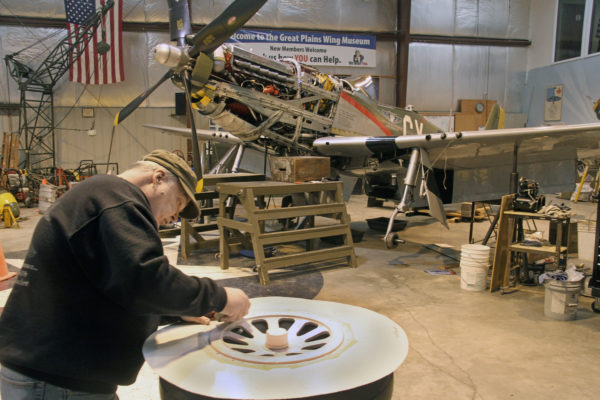
Jim Mason carefully sands a hub for one of Gunfighter’s three wheels. The P-51 Mustang built during World War II is on display at the Council Bluffs Municipal Airport and can be seen at airshows. Photo by Mike Whye
See P-51 Mustang ‘Gunfighter’ at Council Bluffs Municipal Airport and at airshow
By Mike Whye
Jim Mason takes his time as he rubs sandpaper across the hub of a wheel that is lying on a work bench in front of him in a hangar at the Council Bluffs Municipal Airport. The work could go faster if he used a power sander, but he refuses to use one.
“A power tool will take too much off,” he said of the grime on the hub which belongs to the P-51 Mustang that’s a few feet behind him. Even though it was on jacks, the slender airplane looked willing to go through the hangar doors on its own for the sky beyond.
“We baby this airplane,” he said of the single-propeller-driven plane festooned with a paint scheme of gray, green and yellow with red accents. Near him, others have removed panels from the wings and fuselage to peer inside the plane with flashlights. They also run their fingers along electrical and control cables, fuel lines, oil lines and more, feeling for the slightest imperfection that could keep this plane from flying.
This is the annual maintenance check of the P-51 Mustang, which has a rootin’ tootin’ two-gun totin’ cartoon character with the name “Gunfighter” emblazoned on its long sleek nose. Since the 1980s, shortly after now-retired U.S. Air Force Brig. Gen. Regis Urschler bought it from a previous owner, Gunfighter has become one of the more recognized aircrafts flying in air shows across the nation.
At the end of each airshow season, which lasts May through October, the plane is closely examined. The P-51 Mustang’s landing gear is removed, the canopy carefully lifted off to provide easy access to the cockpit and every fastener and electrical circuit is checked. The mighty 1,490-horsepower Merlin engine, that gulps a gallon of aviation gas a minute when flying, also goes to pieces, so to speak. The engine block is painted fire-engine red which makes it easy to spot any oil leaks.
TO READ MORE ABOUT THIS STORY AND OTHER FASCINATING STORIES ABOUT IOWA HISTORY, subscribe to Iowa History Journal. You can also purchase back issues at the store.
